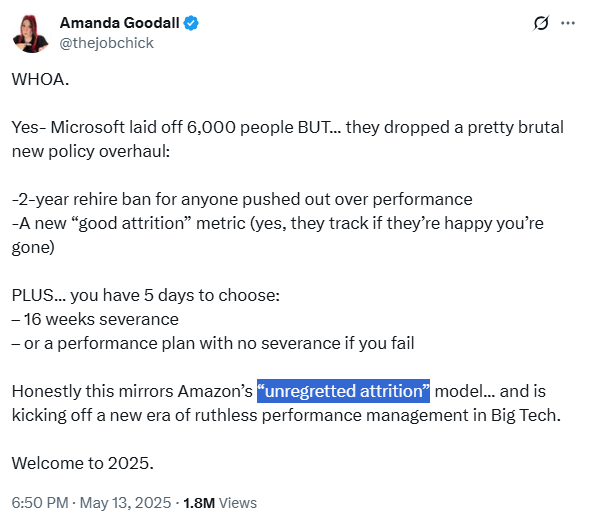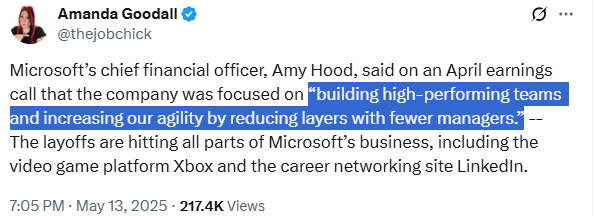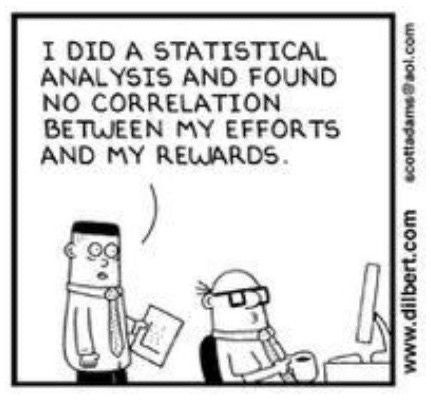How Microsoft Manages Performance
If You Thought Amazon Was Bad...
A QUICK FOLLOW-UP to my earlier post on Amazon’s new five-layer compensation/performance management model, we have some emerging details about Microsoft’s layoffs of over 6,000 employees, mostly managers, across a wide swathe of the company. I came across the above-pictured post on X that includes some rather disturbing details about the venerable tech giant’s contributions to management that this round of redundancies has revealed, including:
A two-year hiring ban for anyone who was “performance-managed” out of the company;
A new KPI to track whether they were right in firing you (“Good Attrition”);
A five-day window to pressure laid off employees to decide whether to accept 16 weeks severance or be put on a PIP with no severance if unsuccessful in meeting the goals;
OP Amanda Goodall likens Microsoft’s “Good Attrition” to Amazon’s “Unregretted Attrition” policy, which pressures managers to hunt down unlikeable poor-performers for dismissal to continually shed the unwanted to keep staffing levels down. Think of it as Stack Ranking meets Hunger Games — it has a similar effect on collaboration and teamwork as everyone looks over their shoulders during appraisal season. Of course, this leads to the target metric being gamed where managers “hire to fire” in order to preserve their teams’ cohesion.
As shown below, COO Amy Hood reports that they are taking these measures to “build high-performing teams” with “fewer layers of managers” to “increase their agility”:
Teamwork Makes the Dream Work…
I will go out on a limb and suggest that despite COO Hood’s earnings call statements, these measures won’t lead to the increase of any agility nor the building of any high-performance teams, but will introduce reverberating dysfunctions as good staff, who through no fault of their own, are unlucky enough to fall on the short-side of their rating/ranking goals, are taken out, leaving ongoing projects in crisis as their knowledge and expertise are lost.
An illustrative example: last year a former coachee told me the story of an executive at one of the big banks in Canada they knew who lost a vital employee to a dragnet of “streamlining” layoffs to reduce costs. This employee was critical to the success of a project the executive was responsible for leading, and in an ironic twist of fate, they weren’t informed of the employee’s layoff until they enquired where they were afterward.
Solution: The employee was hired back as a consultant for 2x their salary. Problem solved!
Deming Analysis
This news from Microsoft underscores how pervasive the misunderstanding of performance as solely attributable to the individual is within modern management culture, along with how cynical the notion of “performance management” has become. We’ve discussed this a number of times in this newsletter, but this new development shows that instead of realizing the error in the practice, the instinct among HR executives and top-management is to come up with ever-degrading “enhancements” with Orwellian names like “Good Attrition” or “Unregretted Attrition”. All miss the point of managing people.
To review why this is a problem from a Deming management perspective:
All organizations operate as a network of interdependent components (people, machines, materials…) that work together as a system to try and accomplish some aim;
It follows that the majority of performance (and problems) are attributable to the way the system’s components were put together by management. In the minority of circumstances, something outside of the system’s control may affect performance.
It further follows that it is not possible to entirely separate the performance of an individual from the system they work within: there is always some entanglement, depending on the task or job to be done.
It further follows that the interactions in a system will vary because there is variation between the components themselves and how they fit together and work together. Therefore, performance of the system varies accordingly.
It finally follows that rating and ranking people for the performance of the system (ie. how management has put the components together) is a gross mistake that misdirects attention away from improving the system and toward swapping “faulty” components. In other words, the system is held in stasis and never improves.
In other words, what Amazon and Microsoft are doing is engaging in managerial Kabuki Theater, ie. giving the appearance of looking good while doing the opposite. It will appease Wall St. with better looking quarters, but ultimately damage the company’s potential over time with less and less innovative spirit. The caveat? If you have so much cash on hand and a pseudo-monopolistic position in the market, you can treat people poorly and just cruise along, but at the expense of even greater gains left on the table.
Reflection Questions
Consider how Microsoft and Amazon implement performance management in their organizations: are the policies justified? Why? Under what circumstances? What theory of management keeps them in place?
How would you describe the prevailing theory of performance management to a new manager? How would you describe the Deming perspective?
What do policies like “Good Attrition” tell you about what the culture at Microsoft? Would you want to work there? How long do you think you’d want to stay vs. how long do you think you’d last? Why?
What will it take to shift the prevailing culture of performance management to one more aligned with Dr. Deming’s theory?
Let’s discuss in the comments below!
Further Reading
Here are some posts I’ve written in the past that deal with the topic of “performance management” from a Deming perspective:











It’s over for the US. At least with this batch of industry ‘leaders’.
There's an interesting parallel that occurs to me. 'Hustle culture' is just rebranded Marxist 'Labor Theory of Value'. The LTV places supremacy on work hours, as does Amazon/Hustle culture's 'just grind 100 hours a week bro'. Deming would have said rework hours don't count. In that sense Deming is the ideological opposite of Hustle/Amazon, which is another proxy for communism, which makes Toyota the ultimate anti-communist manufacturer.
Taking it even another step further look at this:
https://en.wikipedia.org/wiki/Stakhanovite_movement
•"The movement took its name from Aleksei Grigorievich Stakhanov, who reportedly, on August 31, 1935, mined 102 tons of coal in less than 6 hours—some 14 times his shift quota.[2] However, "competitive" Stakhanovite followers soon would "break" his record.[2] On February 1, 1936, it was reported that Nikita Izotov had mined 640 tons[citation needed] of coal in a single shift."
You could swap out the nouns and describe Amazon warehouse propaganda, a Linkedin post or Silicon Valley 'sigma grindset'.
https://theconversation.com/how-a-soviet-miner-from-the-1930s-helped-create-todays-intense-corporate-workplace-culture-155814
•"So quotas were engineered in a way which we might recognise today: by the forced distribution or “stack ranking” of all employees according to their performance.
After all, how many high-performers can there be at any one time? The former CEO of General Electric, Jack Welch, suggested 20% (no more, no less) every year. "
Stack ranking. This is almost literally word-for-word what Deming said NOT to do. People claim the recent hustle overwork culture is the fault of capitalism but I suggest it is explicitly communist, socialist and in particular the living implementation of the Labor Theory of Value. Communism and Hustle culture alike place all blame on the worker and not the manager. And you get the same output: low quality, missed quotas, lost industry. Microsoft and Amazon are...communists??